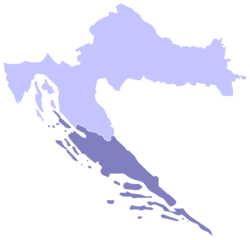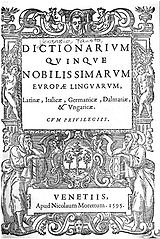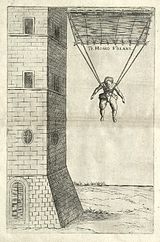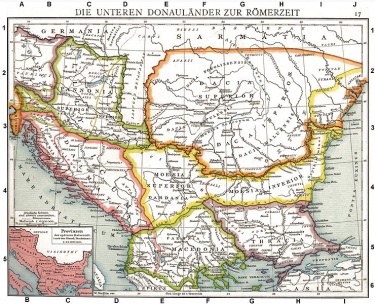Difference between revisions of "Directory:Faust VranÄić"
m (FIX Link) |
m (This is a minor: I have indicated the date because edits on Wikipedia are constant, some articles change daily!) |
||
| Line 4: | Line 4: | ||
'''Fausto Veranzio''' is another article on Wikipedia that exhibits [[Nationalistic Editing on Wikipedia|nationalistic editing]]. Fausto Veranzio or ''Faust Vrančić'' in modern [[Croatia|Croatian]] <ref> Pronounced in Croatian -''Vranchich''. The last ''ch'' is pronounce more softly.</ref> is a individual with a Dalmatian heritage.<ref>[http://books.google.co.uk/books?id=wBg90lSgkQQC&pg=PA121&dq=Travels+Into+Dalmatia++Veranzio&hl=en&ei=eYSsTJ6_M4q4vgPk6oWnBw&sa=X&oi=book_result&ct=result&resnum=1&ved=0CDIQ6AEwAA#v=onepage&q&f=false Travels Into Dalmatia] by Abbe Alberto Fortis (p121)</ref> Fausto was born in Šibenik <ref>[http://books.google.com.au/books?id=6GgyiMd6u8MC&pg=PA95&dq=Fausto+Veranzio+Sebenico&hl=en&ei=dNqSTdriN4X5cdCKzYkH&sa=X&oi=book_result&ct=result&resnum=1&ved=0CCkQ6AEwAA#v=onepage&q=Fausto%20Veranzio%20Sebenico&f=false Ancient Engineers' Inventions:] Precursors of the Present ''by'' Cesare Rossi, Flavio Russo & Ferruccio Russo (p95) | '''Fausto Veranzio''' is another article on Wikipedia that exhibits [[Nationalistic Editing on Wikipedia|nationalistic editing]]. Fausto Veranzio or ''Faust Vrančić'' in modern [[Croatia|Croatian]] <ref> Pronounced in Croatian -''Vranchich''. The last ''ch'' is pronounce more softly.</ref> is a individual with a Dalmatian heritage.<ref>[http://books.google.co.uk/books?id=wBg90lSgkQQC&pg=PA121&dq=Travels+Into+Dalmatia++Veranzio&hl=en&ei=eYSsTJ6_M4q4vgPk6oWnBw&sa=X&oi=book_result&ct=result&resnum=1&ved=0CDIQ6AEwAA#v=onepage&q&f=false Travels Into Dalmatia] by Abbe Alberto Fortis (p121)</ref> Fausto was born in Šibenik <ref>[http://books.google.com.au/books?id=6GgyiMd6u8MC&pg=PA95&dq=Fausto+Veranzio+Sebenico&hl=en&ei=dNqSTdriN4X5cdCKzYkH&sa=X&oi=book_result&ct=result&resnum=1&ved=0CCkQ6AEwAA#v=onepage&q=Fausto%20Veranzio%20Sebenico&f=false Ancient Engineers' Inventions:] Precursors of the Present ''by'' Cesare Rossi, Flavio Russo & Ferruccio Russo (p95) | ||
* According to some sources the settlement (Šibenik) was established by Croatians (Slavs) in the 11th century, and was given its name, '''Šibenik''' (the Š is pronounced ''sh'' ). The Slavs invaded the region in the early Middle Ages. It was latter renamed Sebenico when in 1492 the city became part of the ''Republic of Venice'' (1412-1797). Its name was change to Šibenik by the Yugoslav regime in 1920.</ref> circa 1551 in '''Dalmatia''', a region of the ''Republic of Venice'' in todays modern Croatia. In the 19th century Dalmatia became a province of the [[Austria|Austro]]-Hungarian Empire (Kingdom of Dalmatia). Dalmatia as a province, dates back to the Roman Empire <ref>[http://books.google.com.au/books?id=j-0LAAAAYAAJ&pg=PA158&dq=Roman+empire+province+Dalmatia&hl=en&ei=jfupTJO8JYuSuwO49cTJDA&sa=X&oi=book_result&ct=result&resnum=2&ved=0CDMQ6AEwAQ#v=onepage&q=Roman%20empire%20province%20Dalmatia&f=false The History of the Decline and Fall of the Roman Empire, Volume 1] by Edward Gibbon (p158)</ref> and is several centuries older than Croatia itself. Additionally he was '''historically''' a citizen of the ''Republic of Venice''. Fausto was a brilliant scientist in his day and is noted for his invention of the parachute.<ref>[http://books.google.co.uk/books?lr=&cd=27&num=100&as_brr=0&id=TM2EAAAAIAAJ&dq=Fausto+Veranzio+italian&q=Fausto+Veranzio+Venetian#search_anchor He's in the Paratroops Now] by Alfred Day Rathbone (p172)</ref> | * According to some sources the settlement (Šibenik) was established by Croatians (Slavs) in the 11th century, and was given its name, '''Šibenik''' (the Š is pronounced ''sh'' ). The Slavs invaded the region in the early Middle Ages. It was latter renamed Sebenico when in 1492 the city became part of the ''Republic of Venice'' (1412-1797). Its name was change to Šibenik by the Yugoslav regime in 1920.</ref> circa 1551 in '''Dalmatia''', a region of the ''Republic of Venice'' in todays modern Croatia. In the 19th century Dalmatia became a province of the [[Austria|Austro]]-Hungarian Empire (Kingdom of Dalmatia). Dalmatia as a province, dates back to the Roman Empire <ref>[http://books.google.com.au/books?id=j-0LAAAAYAAJ&pg=PA158&dq=Roman+empire+province+Dalmatia&hl=en&ei=jfupTJO8JYuSuwO49cTJDA&sa=X&oi=book_result&ct=result&resnum=2&ved=0CDMQ6AEwAQ#v=onepage&q=Roman%20empire%20province%20Dalmatia&f=false The History of the Decline and Fall of the Roman Empire, Volume 1] by Edward Gibbon (p158)</ref> and is several centuries older than Croatia itself. Additionally he was '''historically''' a citizen of the ''Republic of Venice''. Fausto was a brilliant scientist in his day and is noted for his invention of the parachute.<ref>[http://books.google.co.uk/books?lr=&cd=27&num=100&as_brr=0&id=TM2EAAAAIAAJ&dq=Fausto+Veranzio+italian&q=Fausto+Veranzio+Venetian#search_anchor He's in the Paratroops Now] by Alfred Day Rathbone (p172)</ref> | ||
| − | *Wikipedia stated on 3rd of October 2010: | + | *Wikipedia stated on 3rd of October 2010. I have indicated the date because edits on Wikipedia are constant, some articles change daily: |
{{Cquote| '' ... he was a polymath and bishop from Croatia.''}} It must be stated as an '''fact''' that: | {{Cquote| '' ... he was a polymath and bishop from Croatia.''}} It must be stated as an '''fact''' that: | ||
* [[Croatia]] only became a sovereign state after 371 years after his death. | * [[Croatia]] only became a sovereign state after 371 years after his death. | ||
| Line 16: | Line 16: | ||
{{Cquote|''There is no justification to falsify history to support ethnic ambitions. The Croats and their Balkan neighbours have done this in a major way'' <ref>[http://books.google.com.au/books?id=wEF5oN5erE0C&pg=PA15&dq=When+ethnicity+did+not+matter+in+the+Balkans++falsify+history&hl=en&ei=vmmZTeq9O4_qvQOtmfj5Cw&sa=X&oi=book_result&ct=result&resnum=1&ved=0CCkQ6AEwAA#v=onepage&q&f=false When Ethnicity did not Matter in the Balkans] by John Van Antwerp Fine (p15)</ref>}} | {{Cquote|''There is no justification to falsify history to support ethnic ambitions. The Croats and their Balkan neighbours have done this in a major way'' <ref>[http://books.google.com.au/books?id=wEF5oN5erE0C&pg=PA15&dq=When+ethnicity+did+not+matter+in+the+Balkans++falsify+history&hl=en&ei=vmmZTeq9O4_qvQOtmfj5Cw&sa=X&oi=book_result&ct=result&resnum=1&ved=0CCkQ6AEwAA#v=onepage&q&f=false When Ethnicity did not Matter in the Balkans] by John Van Antwerp Fine (p15)</ref>}} | ||
== More on Fausto Veranzio == | == More on Fausto Veranzio == | ||
| − | Fausto Veranzio in 1595 published (in Venice) a dictionary called ''"Dictionarium quinque nobilissimarum Europae linguarum : Latinae, Italicae, Germanicae, Dalmatiae & Ungaricae"'' (Dictionary of Five Most Noble European Languages: The Latin, Italian, German, Hungarian | + | Fausto Veranzio in 1595 published (in Venice) a dictionary called ''"Dictionarium quinque nobilissimarum Europae linguarum : Latinae, Italicae, Germanicae, Dalmatiae & Ungaricae"'' (Dictionary of Five Most Noble European Languages: The Latin, Italian, German, Dalmatia and Hungarian). In his dictionary he referred to his native language <ref>'''Note:''' It is important to ''mention'' that Fausto Veranzio native Šibenik (language) is based on old Croatian Chakavian. It also has [[Italian language|Italian]] from the Venetian dialect.</ref> as Dalmatian. [http://www.library.yale.edu/slavic/croatia/dictionary/1103079_m.jpg Front cover-'''link'''.] |
In 1617, (then sixty-five years old) implemented his design and tested the parachute by jumping from St Mark's Campanile in Venice. The 17th century ''Brooklyn Tidal Mill'' in Long Island (New York), is based on his design and is one of the few still standing mills in the [[New York|New York City]] area. | In 1617, (then sixty-five years old) implemented his design and tested the parachute by jumping from St Mark's Campanile in Venice. The 17th century ''Brooklyn Tidal Mill'' in Long Island (New York), is based on his design and is one of the few still standing mills in the [[New York|New York City]] area. | ||
Revision as of 09:03, 7 April 2011
This is about Wikipedia's article on Fausto Veranzio.

Fausto Veranzio is another article on Wikipedia that exhibits nationalistic editing. Fausto Veranzio or Faust Vrančić in modern Croatian [1] is a individual with a Dalmatian heritage.[2] Fausto was born in Šibenik [3] circa 1551 in Dalmatia, a region of the Republic of Venice in todays modern Croatia. In the 19th century Dalmatia became a province of the Austro-Hungarian Empire (Kingdom of Dalmatia). Dalmatia as a province, dates back to the Roman Empire [4] and is several centuries older than Croatia itself. Additionally he was historically a citizen of the Republic of Venice. Fausto was a brilliant scientist in his day and is noted for his invention of the parachute.[5]
- Wikipedia stated on 3rd of October 2010. I have indicated the date because edits on Wikipedia are constant, some articles change daily:
| “ | ... he was a polymath and bishop from Croatia. | ” |
It must be stated as an fact that:
- Croatia only became a sovereign state after 371 years after his death.
- Dalmatia was not part of Croatia until the middle of the 20th century.[6]
- Croatia itself has not been a sovereign independent state for nine centuries.
This is using the Wikipedia's article for nationalistic propaganda and is not based on fact. It otherwise tainted a perfectly good article on this unique individual. Some of the Croatian Wiki-Editors just can't separate ultra-extreme nationalistic propaganda from an unbiased historical perspective.
John Van Antwerp Fine (Professor Emeritus of History at the University of Michigan) on Croatian History:
| “ | There is no justification to falsify history to support ethnic ambitions. The Croats and their Balkan neighbours have done this in a major way [7] | ” |
More on Fausto Veranzio
Fausto Veranzio in 1595 published (in Venice) a dictionary called "Dictionarium quinque nobilissimarum Europae linguarum : Latinae, Italicae, Germanicae, Dalmatiae & Ungaricae" (Dictionary of Five Most Noble European Languages: The Latin, Italian, German, Dalmatia and Hungarian). In his dictionary he referred to his native language [8] as Dalmatian. Front cover-link.
In 1617, (then sixty-five years old) implemented his design and tested the parachute by jumping from St Mark's Campanile in Venice. The 17th century Brooklyn Tidal Mill in Long Island (New York), is based on his design and is one of the few still standing mills in the New York City area.
Today a Croatian Navy rescue ship bears the name Faust Vrančić.
Historical Perspectives on Dalmatia
Dalmatia is a region of Europe with a very multicultural and multiethnic history.
Encyclopedia Britannica
- Encyclopedia Britannica-Dalmatia
| “ |
|
” |
Sir John Gardner Wilkinson
Sir John Gardner Wilkinson (1797 – 1875) was an English traveller, writer and pioneer Egyptologist of the 19th century. He is often referred to as "the Father of British Egyptology". He was in Dubrovnik (then called Ragusa) in 1848, he wrote in his; Dalmatia and Montenegro: With a Journey to Mostar in Herzegovina.Volume 1:
| “ | Italian is spoken in all the seaports of Dalmatia, but the language of the country is a dialect of the Slavonic, which alone is used by peasants in the interior.[12] | ” |
| “ | Their language though gradually falling into Venetianisms of the other Dalmatians towns, still retains some of that pure Italian idiom, for which was always noted. [13] | ” |
Maude Holbach (a 1910 travel guide)
- Dalmatia-The Land Where East Meets West by Maude Holbach (a 1910 travel guide from COSIMO books and publications New York USA):
| “ | Two hundred years later that, is, early in the tenth century you might have heard Slavish and Latin spoken had you walked in the streets of Ragusa (Editors note: Dubrovnik),[14] just as you hear Slavish and Italian today; for as times of peace followed times of war, the Greek and Roman inhabitants of Rausium intermarried with the surrounding Slavs, and so a mixed race sprang up, a people apart from the rest of Dalmatia. [15] | ” |
See also
- Nationalistic Editing on Wikipedia
- Worst of Wikipedia
- Top 10 Reasons Not to Donate to Wikipedia
- The Wikipedia Point of View
- The Wikipedia Point of View/Activists

"Dictionarivm qvinqve nobilissimarvm Evropæ lingvarvm, latinæ, italicæ, germanicæ, dalmatiæ, & vngaricæ"
(Venetiis: Apud Nicolaum Morettum, 1595) [16]
References
- ^ Pronounced in Croatian -Vranchich. The last ch is pronounce more softly.
- ^ Travels Into Dalmatia by Abbe Alberto Fortis (p121)
- ^ Ancient Engineers' Inventions: Precursors of the Present by Cesare Rossi, Flavio Russo & Ferruccio Russo (p95)
- According to some sources the settlement (Šibenik) was established by Croatians (Slavs) in the 11th century, and was given its name, Šibenik (the Š is pronounced sh ). The Slavs invaded the region in the early Middle Ages. It was latter renamed Sebenico when in 1492 the city became part of the Republic of Venice (1412-1797). Its name was change to Šibenik by the Yugoslav regime in 1920.
- ^ The History of the Decline and Fall of the Roman Empire, Volume 1 by Edward Gibbon (p158)
- ^ He's in the Paratroops Now by Alfred Day Rathbone (p172)
- ^ Under the Treaty of Rapallo (in 1920 between Italy and the Kingdom of Serbia, Croatia & Slovenia.), Dalmatia became part of the Kingdom of Serbia, Croatia & Slovenia which was renamed Kingdom of Yugoslavia in 1929. After World War II Dalmatia was divided between three republics of Communist Yugoslavia. Most of territory went to Croatia. In 1991 the Republic of Croatia became independent.
- ^ When Ethnicity did not Matter in the Balkans by John Van Antwerp Fine (p15)
- ^ Note: It is important to mention that Fausto Veranzio native Šibenik (language) is based on old Croatian Chakavian. It also has Italian from the Venetian dialect.
- ^ <templatestyles src="Module:Citation/CS1/styles.css"></templatestyles>"Encyclopedia Britannica: Ladislas". 2010. Retrieved 2010-10-06. Check date values in:
|date=(help) - ^ Note: Added Dalmatia as it is referring to the country/province Dalmatia .
- ^ Encyclopedia Britannica: Dalmatia
- ^ Dalmatia and Montenegro: With a journey to Mostar in Herzegovina. Volume 1 by Sir John Gardner Wilkinson (p4)
- ^ Dalmatia and Montenegro: With a journey to Mostar in Herzegovina. Volume 1 by Sir John Gardner Wilkinson (p362)
- ^ City of Dubrovnik original name was Ragusa.
- ^ Dalmatia: The Land Where East Meets West by Maude Holbach (p121)
- "DALMATIA: The Land Where East Meets West is MAUDE M. HOLBACH's second book of travel in Eastern Europe. First published in 1910, this is an anthropological travel journal of an often-overlooked kingdom" Web site: www.cosimobooks.com
- ^ www.library.yale.edu
External links
More on nationalistic editing on Wikipedia (below).
- Francesco Patrizi: BEYOND NECESSITY- Francesco Patrizi link
The case of Francesco Patrizi, the Venetian philosopher, is a fine illustration of the nationalistic warfare that is part of Wikipedia, and the inaccuracy, falsehood and bias that follows as a result.
Quote by Ocham-London, United Kingdom:
| “ | The problem becomes particularly acute in a place like Wikipedia, where the only intellectual interest - that is to say, no intellectual interest at all - lies simply in a nationalistic dispute, in this case between Italians and Croatians. | ” |
- Veranzio's, Machinae Novae (Venice 1595) contained designs of 56 different machines, tools, devices and technical concepts. Two variants of this work exist, one with the "Declaratio" in Latin and Italian. The book was latter written in German, French and Spanish. Veranzio died in Venice in 1617 and was buried in Dalmatia, near by his family's country house.
<sharethis />



